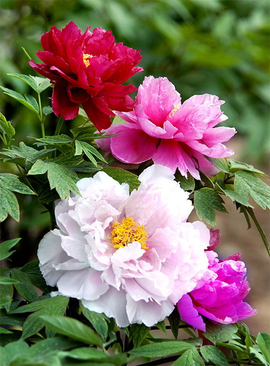
Peony (scientific name: Paeonia suffruticosa Andr.) is a plant of the family Ranunculaceae and the genus Paeoniae, and is a perennial deciduous shrub.
Stems up to 2 m; branches short and thick. The leaves are usually two times three compound leaves, and occasionally the leaves near the top of the branches are 3 leaflets; the terminal leaflets are broadly ovate, the surface is green, glabrous, the back is light green, sometimes with white powder, and the lateral leaflets are narrowly ovate or oblong Oval, petiole 5-11 cm long, and rachis glabrous. Flowers solitary at the top of branches, bracts 5, oblong; sepals 5, green, broadly ovate, petals 5 or double, rose, reddish-purple, pink to white, usually very variable, obovate, top notched Regularly undulate; anthers oblong, 4 mm long; disc leathery, cup-shaped, purple-red; carpels 5, more sparse, densely pilose. Follicles oblong, densely yellow-brown bristles. Flowering in May; fruiting in June.
The flowers are bright in color, fragrant with jade smiles and pearls, romantic and unrestrained, magnificent, known as the “king of flowers”. In the cultivation type, it can be divided into hundreds of varieties mainly according to the color of the flowers. “There are many varieties of peonies, and there are many colors. Yellow, green, flesh red, deep red, and silver red are the top grades, especially yellow and green are the most expensive. Peony flowers are large and fragrant, so they are also known as “national beauty and heavenly fragrance”. Tang Dynasty Liu Yuxi has a poem saying: “The peony in front of the court is invincible, and the lotus on the pond is pure and seldom affectionate. Only the peony is truly national, and the capital moves when it blooms. “. At the end of the Qing Dynasty, the peony was once regarded as China’s national flower. In May 1985, the peony was rated as the second of China’s top ten famous flowers. It is a unique woody and precious flower in China. It has thousands of years of natural growth and more than 1,500 years of History of artificial cultivation.
Peony (scientific name: Paeonia suffruticosa Andr.) is a plant of the family Ranunculaceae and the genus Paeoniae, and is a perennial deciduous shrub.
Stems up to 2 m; branches short and thick. The leaves are usually two times three compound leaves, and occasionally the leaves near the top of the branches are 3 leaflets; the terminal leaflets are broadly ovate, the surface is green, glabrous, the back is light green, sometimes with white powder, and the lateral leaflets are narrowly ovate or oblong Oval, petiole 5-11 cm long, and rachis glabrous. Flowers solitary at the top of branches, bracts 5, oblong; sepals 5, green, broadly ovate, petals 5 or double, rose, reddish-purple, pink to white, usually very variable, obovate, top notched Regularly undulate; anthers oblong, 4 mm long; disc leathery, cup-shaped, purple-red; carpels 5, more sparse, densely pilose. Follicles oblong, densely yellow-brown bristles. Flowering in May; fruiting in June.
The flowers are bright in color, fragrant with jade smiles and pearls, romantic and unrestrained, magnificent, known as the “king of flowers”. In the cultivation type, it can be divided into hundreds of varieties mainly according to the color of the flowers. “There are many varieties of peonies, and there are many colors. Yellow, green, flesh red, deep red, and silver red are the top grades, especially yellow and green are the most expensive. Peony flowers are large and fragrant, so they are also known as “national beauty and heavenly fragrance”. Tang Dynasty Liu Yuxi has a poem saying: “The peony in front of the court is invincible, and the lotus on the pond is pure and seldom affectionate. Only the peony is truly national, and the capital moves when it blooms. “. At the end of the Qing Dynasty, the peony was once regarded as China’s national flower. In May 1985, the peony was rated as the second of China’s top ten famous flowers. It is a unique woody and precious flower in China. It has thousands of years of natural growth and more than 1,500 years of History of artificial cultivation.
